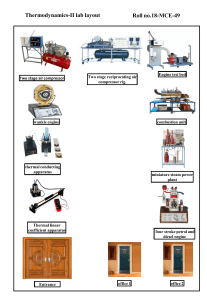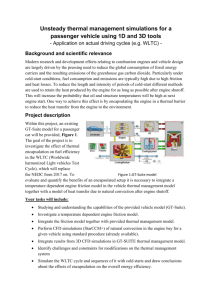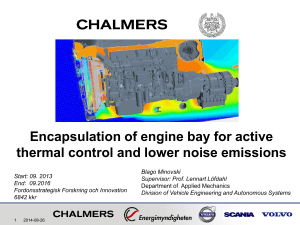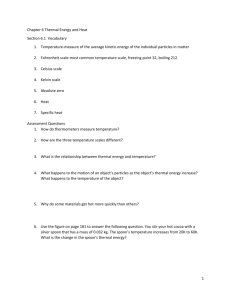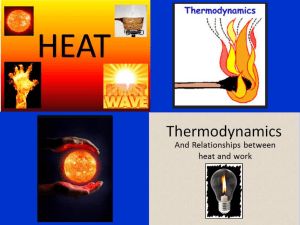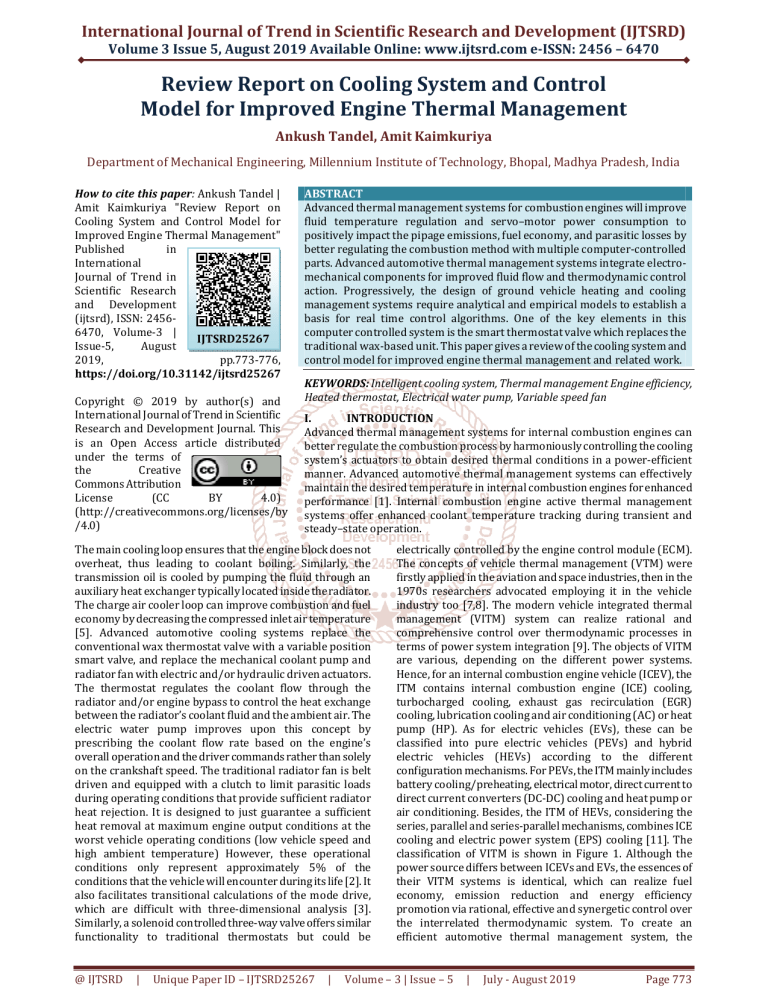
International Journal of Trend in Scientific Research and Development (IJTSRD)
Volume 3 Issue 5, August 2019 Available Online: www.ijtsrd.com e-ISSN: 2456 – 6470
Review Report on Cooling System and Control
Model for Improved Engine Thermal Management
Ankush Tandel, Amit Kaimkuriya
Department of Mechanical Engineering, Millennium Institute of Technology, Bhopal, Madhya Pradesh, India
How to cite this paper: Ankush Tandel |
Amit Kaimkuriya "Review Report on
Cooling System and Control Model for
Improved Engine Thermal Management"
Published
in
International
Journal of Trend in
Scientific Research
and Development
(ijtsrd), ISSN: 24566470, Volume-3 |
IJTSRD25267
Issue-5,
August
2019,
pp.773-776,
https://doi.org/10.31142/ijtsrd25267
Copyright © 2019 by author(s) and
International Journal of Trend in Scientific
Research and Development Journal. This
is an Open Access article distributed
under the terms of
the
Creative
Commons Attribution
License
(CC
BY
4.0)
(http://creativecommons.org/licenses/by
/4.0)
ABSTRACT
Advanced thermal management systems for combustion engines will improve
fluid temperature regulation and servo–motor power consumption to
positively impact the pipage emissions, fuel economy, and parasitic losses by
better regulating the combustion method with multiple computer-controlled
parts. Advanced automotive thermal management systems integrate electromechanical components for improved fluid flow and thermodynamic control
action. Progressively, the design of ground vehicle heating and cooling
management systems require analytical and empirical models to establish a
basis for real time control algorithms. One of the key elements in this
computer controlled system is the smart thermostat valve which replaces the
traditional wax-based unit. This paper gives a review of the cooling system and
control model for improved engine thermal management and related work.
KEYWORDS: Intelligent cooling system, Thermal management Engine efficiency,
Heated thermostat, Electrical water pump, Variable speed fan
I.
INTRODUCTION
Advanced thermal management systems for internal combustion engines can
better regulate the combustion process by harmoniously controlling the cooling
system’s actuators to obtain desired thermal conditions in a power-efficient
manner. Advanced automotive thermal management systems can effectively
maintain the desired temperature in internal combustion engines for enhanced
performance [1]. Internal combustion engine active thermal management
systems offer enhanced coolant temperature tracking during transient and
steady–state operation.
The main cooling loop ensures that the engine block does not
overheat, thus leading to coolant boiling. Similarly, the
transmission oil is cooled by pumping the fluid through an
auxiliary heat exchanger typically located inside the radiator.
The charge air cooler loop can improve combustion and fuel
economy by decreasing the compressed inlet air temperature
[5]. Advanced automotive cooling systems replace the
conventional wax thermostat valve with a variable position
smart valve, and replace the mechanical coolant pump and
radiator fan with electric and/or hydraulic driven actuators.
The thermostat regulates the coolant flow through the
radiator and/or engine bypass to control the heat exchange
between the radiator’s coolant fluid and the ambient air. The
electric water pump improves upon this concept by
prescribing the coolant flow rate based on the engine’s
overall operation and the driver commands rather than solely
on the crankshaft speed. The traditional radiator fan is belt
driven and equipped with a clutch to limit parasitic loads
during operating conditions that provide sufficient radiator
heat rejection. It is designed to just guarantee a sufficient
heat removal at maximum engine output conditions at the
worst vehicle operating conditions (low vehicle speed and
high ambient temperature) However, these operational
conditions only represent approximately 5% of the
conditions that the vehicle will encounter during its life [2]. It
also facilitates transitional calculations of the mode drive,
which are difficult with three-dimensional analysis [3].
Similarly, a solenoid controlled three-way valve offers similar
functionality to traditional thermostats but could be
@ IJTSRD
|
Unique Paper ID – IJTSRD25267
|
electrically controlled by the engine control module (ECM).
The concepts of vehicle thermal management (VTM) were
firstly applied in the aviation and space industries, then in the
1970s researchers advocated employing it in the vehicle
industry too [7,8]. The modern vehicle integrated thermal
management (VITM) system can realize rational and
comprehensive control over thermodynamic processes in
terms of power system integration [9]. The objects of VITM
are various, depending on the different power systems.
Hence, for an internal combustion engine vehicle (ICEV), the
ITM contains internal combustion engine (ICE) cooling,
turbocharged cooling, exhaust gas recirculation (EGR)
cooling, lubrication cooling and air conditioning (AC) or heat
pump (HP). As for electric vehicles (EVs), these can be
classified into pure electric vehicles (PEVs) and hybrid
electric vehicles (HEVs) according to the different
configuration mechanisms. For PEVs, the ITM mainly includes
battery cooling/preheating, electrical motor, direct current to
direct current converters (DC-DC) cooling and heat pump or
air conditioning. Besides, the ITM of HEVs, considering the
series, parallel and series-parallel mechanisms, combines ICE
cooling and electric power system (EPS) cooling [11]. The
classification of VITM is shown in Figure 1. Although the
power source differs between ICEVs and EVs, the essences of
their VITM systems is identical, which can realize fuel
economy, emission reduction and energy efficiency
promotion via rational, effective and synergetic control over
the interrelated thermodynamic system. To create an
efficient automotive thermal management system, the
Volume – 3 | Issue – 5
|
July - August 2019
Page 773
International Journal of Trend in Scientific Research and Development (IJTSRD) @ www.ijtsrd.com eISSN: 2456-6470
vehicle’s cooling system behavior and transient response
must be analyzed. In [8] pursued a lumped parameter
modeling approach and presented multi-node thermal
models which estimated internal engine temperature. In [7]
created a mathematical model to analytically predict the
dynamic behavior of a 4.6L spark-ignition engine. To
accompany the mathematical model, analytical/empirical
descriptions were developed to describe the smart cooling
system components.
II.
Literature Survey
Arya K. Haghighat et. al. [1] “An intelligent cooling system and
control model for improved engine thermal management”
Engine performance was improved over all parts of the NEDC
cycle, including engine warm-up and both high and low
engine load conditions. A controlling model for the cooling
system of an engine was developed in order to reduce fuel
consumption and engine emissions through the use of
controllable engine cooling components including an
electrical water pump, an electrical fan, and a heater
thermostat. This model was based on engine characteristics
that were derived from several experiments on a 1.4 L
engine. In this model, a control program is suggested that can
control the different active intelligent components. The
results of simulations using the derived engine model showed
that fuel consumption decreases 1.1% for the intelligent
cooling system under NEDC cycle operation compared to a
conventional cooling system.
Soheil Jafari et. al. [2] “A review of evaporative cooling system
concepts for engine thermal management in motor vehicles”
The purposes of this review are to establish the evident
system shortcomings and to identify the remaining research
questions that need to be addressed to enable this important
technology to be adopted by vehicle manufacturers. The
evaporative cooling system concepts proposed over the past
century for engine thermal management in automotive
applications are examined and critically reviewed. EC
systems proposed over the past century were examined.
Initially, the physical principles and the benefits of EC were
expounded together with the state-of-the-art capability for
modeling and numerical simulations. If these research
challenges are overcome, it will then be possible to establish
the control variables that achieve peak heat flux levels
comparable with those of state-of-the-art sub-cooled systems.
Kevin Bennion et. al. [3] “Integrated Vehicle Thermal
Management for Advanced Vehicle Propulsion Technologies”
A critical element to the success of new propulsion
technologies that enable reductions in fuel use is the
integration of component thermal management technologies
within a viable vehicle package. Integrated vehicle thermal
management is one pathway to address the cost, weight, and
size challenges. The integration of the power electronics and
electric machine (PEEM) thermal management with other
existing vehicle systems is one path for reducing the cost of
electric drive systems. This work demonstrates techniques
for evaluating and quantifying the integrated transient and
continuous heat loads of combined systems incorporating
electric drive systems that operate primarily under transient
duty cycles, but the approach can be extended to include
additional steady-state duty cycles typical for designing
vehicle thermal management systems of conventional
vehicles. The proposed method of using the generated heat
load curve provided a method for evaluating the transient
@ IJTSRD
|
Unique Paper ID – IJTSRD25267
|
and continuous heat loads of individual components and
integrated thermal management systems over actual in-use
conditions for components that experience significant
transient use.
Yan Wang et. al. [4] “Advances in Integrated Vehicle Thermal
Management and Numerical Simulation” This article reviews
relevant researching work and current advances in the everbroadening field of modern vehicle thermal management
(VTM). Based on the systematic summaries of the design
methods and applications of ITM, future tasks and proposals
are presented. This article aims to promote innovation of
ITM, strengthen the precise control and the performance
predictable ability, furthermore, to enhance the level of
research and development (R&D). To pursue high efficiency
and lightweight in automobile design, the power system and
its vehicle integrated thermal management (VITM) system
have attracted widespread attention as the major
components of modern vehicle technology. According to the
different power sources, the research objects of VITM are
quite different to some extent. Regarding ICEVs, their thermal
management systems contain ICE cooling, turbo-charged
cooling, exhaust gas recirculation cooling, lubrication cooling,
and air conditioning or heat pump.
H H Pang et. al. [5] “Review of engine cooling technologies for
modern engines” The performance of the conventional
engine-cooling system has always been constrained by the
passive nature of the system and the need to provide the
required heat-rejection capability at high-power conditions.
This leads to considerable losses in the cooling system at
part-load conditions where vehicles operate most of the time.
A set of design and operating features from advanced engine
cooling systems is reviewed and evaluated for their potential
to provide improved engine protection while improving fuel
efficiency and emissions output. The controllable element can
also be employed to maintain oil and block temperature
within its design-operating range for low frictional losses and
emissions impact. Though this is an ideal arrangement for the
engine cooling structure itself, the design and requirement of
external circuits have considerable influence on the
performance of the whole ECS.
Pradeep Setlur et. al. [6] “An Advanced Engine Thermal
Management System: Nonlinear Control and Test” Internal
combustion engine thermal management system
functionality can be enhanced through the introduction of
smart thermostat valves and variable speed electric pumps
and fans. To study these cooling system actuators, with
accompanying nonlinear control strategy, a scale
experimental system has been fabricated which features a
smart valve, electric coolant pump, radiator with electric fan,
and immersion heater. In this paper, mathematical models
will be presented to describe the system’s behavior. The
thermal management system for gasoline and diesel engines
can benefit from the introduction of mechatronic system
components that provide greater control over the
heating/cooling process.
THERMAL MANAGEMENT
III.
The term “thermal management” describes the efficient
control of thermal energy flows in the vehicle in accordance
with the specific requirements and the prevailing operating
and load conditions. As a result, vehicle emissions can be
reduced; also the thermal state, friction torque and
Volume – 3 | Issue – 5
|
July - August 2019
Page 774
International Journal of Trend in Scientific Research and Development (IJTSRD) @ www.ijtsrd.com eISSN: 2456-6470
mechanical engine efficiency can be improved. This leads to
lower fuel consumption, longer engine life, and the upswing
in thermal comfort. The key benefits of thermal management
systems can be
Summarized as follow:
Reduce parasitic power losses.
Improve cooling system control.
Quicker engine warm-up during cold start.
Reduce engine wear and friction.
Increase lubricant life.
Increase the average combustion temperature.
Enhance fuel economy.
Decrease exhaust emissions.
Eliminating hot soak after an engine stop.
temperature conditions within the cylinder. HCCI
combustion has the potential of lower emissions than in
traditional SI and CI engines. Fuel economy benefits of over
16% over an EPA City Drive Cycle with HCCI implementation
on a baseline. L direct-injected engine with twinindependent VVT and EGR have been demonstrated. Several
other studies provide insight into the fuel economy benefits
of implementing HCCI technology. As HCCI combustion is
based on self-ignition, it leads to problems with engine
knocking and durability of the engine. With the development
of better techniques of Controlled Auto-Ignition (CAI), to
harness the full potential of HCCI technology by avoiding
problems related to pre-ignition and engine knock, HCCI
combustion promises to be an integral part of future engines.
IV.
B. Automotive Cooling Systems
To introduce the work in the field of automotive cooling
systems, a list of references is presented which offers insight
to the past and current work. In [13] considered an advanced
thermal management system capable of fuel efficiency
benefits of up to 5%. The electric water pump introduced a
1.9 kW reduction in parasitic losses. In [12] introduced the
need for an electrical water valve for the thermal
management intelligent system as an alternative to the
passive wax thermostat operating as a water bypass valve. In
[14] presented a smart thermostat and coolant pump to
control engine thermal management. The presented valve
was a linearly actuated three-way valve to control the bypass
and radiator coolant flow. In [11] introduced a smart
thermal management system that reduced warm-up time,
temperature tracking errors and power consumption of the
electrically actuated cooling components. In [12] presented
an enhanced vehicle and engine cooling system simulation
through the coupling of advanced engine and cooling system
computer-based simulation tool. This active cooling
simulation was applied to a Detroit Diesel series 60 engine
where power consumption and engine warm-up time
reduction was studied.
Overview of Advancements in Engine and Power
train Technology
After Advancements in propulsion technology, those
implemented as well as those under development, may be
classified into two basic categories: 1) those that entail
modifications of existing hardware leading to improvement
via design optimization, and 2) those that entail the addition
of newly developed hardware (mechanical as well as
electrical components). Also, another significant
advancement in modern automobiles, in the form of a nonpropulsion technology, is the capability to formulate more
sophisticated control architectures for controlling complex
systems that have a high level of interdependency. Typically,
a combination of all these three approaches is today applied
in the design of vehicles. Modifications to existing engine and
power train related technological practices imply replacing
the hardware with more robust and capable components,
implementation of more involved control strategies as well as
a combination of the two. Modifications made to power trains
at present include improvements to combustion processes,
start-stop technology reduction of weight using lighter
materials. Engineering more efficient auxiliary components
such as coolant pumps, air-conditioning systems, cooling fans
etc., The advancements mentioned above may also be
classified based on system-level improvements, via
modification or new development, made to one of the
following vehicular systems:
Improvement to engine combustion and air-path
systems;
Improved transmission and driveline technologies;
Vehicle system optimization (reduction of vehicle mass,
use of lighter and stronger materials, engine thermal
management, ancillary load reduction);
A. Improvement to engine combustion and air-path
systems
Improvements to combustion events are generally oriented
towards increasing combustion efficiency and reduce its
duration. Fast-burn combustion systems are used to increase
the efficiency of SI engines by increasing the fuel burn-rate
to attain higher peak pressures and temperatures [2.8]. This
is possible by developing more turbulence in the air-fuel
mixing process and obtaining a more uniform charge
formation. This is the concept, for example, behind
Homogenous-Charge Compression Ignition (HCCI). Engines,
which has received much attention recently. HCCI
combustion involves a premixed, homogeneous charge of air,
fuel and residual gases that is combusted by auto-ignition.
The main feature of HCCI combustion is the self-ignition
process that results from tight control of the pressure and
@ IJTSRD
|
Unique Paper ID – IJTSRD25267
|
Rigorous models have been used in the development of the
simulation system. A classical PID controller, with
combinations of feedback and feed-forward control, was
used as well as special transport delays. In [16] presented a
light-duty diesel.
Conclusion
In this paper study is oriented on an intelligent cooling
system and control model for improved engine thermal
management and related work. In [1] controlling model for
the cooling system of an engine was developed in order to
reduce fuel consumption and engine emissions through the
use of controllable engine cooling components including an
electrical water pump, an electrical fan, and a heater
thermostat. In [2] EC systems proposed over the past
century were examined. Initially, the physical principles and
the benefits of EC were expounded together with the stateof-the-art capability for modeling and numerical simulations.
References
[1] Haghighat, Arya K., Soheil Roumi, Navid Madani,
Davoud Bahmanpour, and Michael G. Olsen. "An
intelligent cooling system and control model for
improved engine thermal management." Applied
Thermal Engineering 128 (2018): 253-263.
Volume – 3 | Issue – 5
|
July - August 2019
Page 775
International Journal of Trend in Scientific Research and Development (IJTSRD) @ www.ijtsrd.com eISSN: 2456-6470
[2] Jafari, Soheil, Julian F. Dunne, Mostafa Langari, Zhiyin
Yang, Jean-Pierre Pirault, Chris A. Long, and Jisjoe
Thalackottore Jose. "A review of evaporative cooling
system concepts for engine thermal management in
motor vehicles." Proceedings of the Institution of
Mechanical Engineers, Part D: Journal of Automobile
Engineering 231, no. 8 (2017): 1126-1143.
[3] Bennion, Kevin, and Matthew Thornton. "Integrated
vehicle thermal management for advanced vehicle
propulsion technologies: Preprint." (2010): 1.
[4] Wang, Yan, Qing Gao, Tianshi Zhang, Guohua Wang,
Zhipeng Jiang, and Yunxia Li. "Advances in Integrated
Vehicle Thermal Management and Numerical
Simulation." Energies 10, no. 10 (2017): 1636.
[5] Pang, H. H., and C. J. Brace. "Review of engine cooling
technologies for modern engines." Proceedings of the
Institution of Mechanical Engineers, Part D: Journal of
Automobile Engineering 218, no. 11 (2004): 12091215.
[6] Setlur, Pradeep, John R. Wagner, Darren M. Dawson,
and Egidio Marotta. "An advanced engine thermal
management system: Nonlinear control and test."
IEEE/ASME transactions on mechatronics 10, no. 2
(2005): 210-220.
[7] Hnatczuk, W. Thermal Management for the 21st
Century—Improved Thermal Control & Fuel Economy
in an Army Medium Tactical Vehicle; SAE Technical
Paper 2005-01-2068; SAE International: Washington,
DC, USA, 2005.
[8] Mahmoud, K.G.; Loibner, E.; Wiesler, B.; Samhaber, C.;
Kußmann, Ch. Simulation-Based Vehicle Thermal
Management System—Concept and Methodology. In
Proceedings of the 2003 SAE World Congress, Detroit,
MI, USA, 3–6 March 2003.
@ IJTSRD
|
Unique Paper ID – IJTSRD25267
|
[9] Gering, K.L.; Haefner, D.R. Methods of Forming Thermal
Management Systems and Thermal Management
Methods. U.S. Patent 8,191,618, 5 June 2012.
[10] Allen, D.A.; Lasecki, M.P. Thermal management
evolution and controlled coolant flow. In Proceedings
of the Vehicle Thermal Management Systems
Conference and Exhibition, Nashville, TN, USA, 14–17
May 2001.
[11] Leslie, S.W. Charles F. Kettering and the copper-cooled
engine. Technol. Cult. 1979, 20, 752–776. [CrossRef]
[12] Briggs, I.; Murtagh, M.; Kee, R.; McCullough, G.; Douglas,
R. Sustainable non-automotive vehicles: The simulation
challenges. Renew. Sustain. Energy Rev. 2017, 68, 840–
851. [CrossRef]
[13] Han, T.; Chen, K.; Khalighi, B.; Curran, A.; Pryor, J.;
Hepokoski, M. Assessment of various environmental
thermal loads on passenger thermal comfort. SAE Int. J.
Passeng. Cars Mech. Syst. 2010, 3, 830–841. [CrossRef]
[14] Zucchetto, J.; Myers, P.; Johnson, J.; Miller, D. An
assessment of the performance and requirements for
“adiabatic” engines. Science 1988, 240, 1157–1162.
[CrossRef] [PubMed]
[15] Dutta, N.; Rouaud, C.; Masera, M.; Beuzelin, F.; Hughes,
C.A.V. Powertrain cooling concept selection process for
hybrid electric vehicles. In Innovations in Fuel
Economy and Sustainable Road Transport; Elsevier
Science: Burlington, NJ, USA, 2011; pp. 61–72.
[16] Rugh, J.P.; Bennion, K.; Brooker, A.; Langewisch, J.;
Smith, K.; Meyer, J. PHEV/EV integrated vehicle
thermal management—Development of a KULI model
to assess combined cooling loops. In-Vehicle Thermal
Management Systems Conference and Exhibition
(VTMS10); Elsevier Science: Burlington, NJ, USA, 2011;
pp. 649–660.
Volume – 3 | Issue – 5
|
July - August 2019
Page 776

